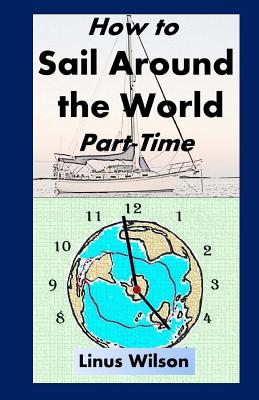How to Sail Around the World Part-Time

How to Sail Around the World Part-Time
Do you dream of sailing around the world in a sailboat? Do you have a business or career you don't want to sacrifice for that dream? Do you have kids in school? You don't need to quit your job, sell your house, and take the kids out of school to complete a circumnavigation of the globe in a sailboat. You don't have to wait until you are retired to sail for the South Pacific. This book tells you how you can do it without uprooting your life by taking as little as two months per year off to sail the trade winds. Circumnavigating the globe in a sailboat is on par with scaling Mount Everest in terms of its rarity. Many potential circumnavigators are hobbled by misconceptions about the journey that mountaineers lack when climbing to the top of the world. It is said, "I want to circumnavigate to see the world." Nevertheless, successful trade wind circumnavigators don't see the world. Instead, they travel on a narrow ribbon around it stopping mostly at a narrow range of countries that are downwind. Lack of focus causes many more failed circumnavigations than storms at sea. The conventional wisdom is that you need to quit your job, sell your house, and live on the boat year-round. The reality is that even retirees circumnavigating full-time keep their boat in port half of the year because of the demands of cyclone season. There is no good way to elude the November to April cyclone season that dominates 60 percent of the trade-wind circumnavigation route. The mad rush from the eastern Caribbean to the "safe" ports in New Zealand and Australia in a single calendar year is misguided. It sets cruisers up for hard, upwind ocean passages in future years and saps the resolve of their crews. A better solution is to haul out their boats in the South Pacific and fly back to their homes in the developed world during the cyclone season. It makes more sense to keep one's job and home and take annual two-to-six month leaves of absences to move the boat forward during the cruising season. This allows the sailors to earn more outside the cruising season. Further, they can maintain the careers and businesses which they have built over many years. Further, cruisers still have a job or business to come back to if they decide that the cruise is not for them. Pursuing a part-time circumnavigation is likely to be far less costly to cruisers' long-term earnings than totally severing ties to one's job or business. Going back to their homes on land is much more comfortable than living
PRP: 92.92 Lei
Acesta este Prețul Recomandat de Producător. Prețul de vânzare al produsului este afișat mai jos.
83.63Lei
83.63Lei
92.92 LeiLivrare in 2-4 saptamani
Descrierea produsului
Do you dream of sailing around the world in a sailboat? Do you have a business or career you don't want to sacrifice for that dream? Do you have kids in school? You don't need to quit your job, sell your house, and take the kids out of school to complete a circumnavigation of the globe in a sailboat. You don't have to wait until you are retired to sail for the South Pacific. This book tells you how you can do it without uprooting your life by taking as little as two months per year off to sail the trade winds. Circumnavigating the globe in a sailboat is on par with scaling Mount Everest in terms of its rarity. Many potential circumnavigators are hobbled by misconceptions about the journey that mountaineers lack when climbing to the top of the world. It is said, "I want to circumnavigate to see the world." Nevertheless, successful trade wind circumnavigators don't see the world. Instead, they travel on a narrow ribbon around it stopping mostly at a narrow range of countries that are downwind. Lack of focus causes many more failed circumnavigations than storms at sea. The conventional wisdom is that you need to quit your job, sell your house, and live on the boat year-round. The reality is that even retirees circumnavigating full-time keep their boat in port half of the year because of the demands of cyclone season. There is no good way to elude the November to April cyclone season that dominates 60 percent of the trade-wind circumnavigation route. The mad rush from the eastern Caribbean to the "safe" ports in New Zealand and Australia in a single calendar year is misguided. It sets cruisers up for hard, upwind ocean passages in future years and saps the resolve of their crews. A better solution is to haul out their boats in the South Pacific and fly back to their homes in the developed world during the cyclone season. It makes more sense to keep one's job and home and take annual two-to-six month leaves of absences to move the boat forward during the cruising season. This allows the sailors to earn more outside the cruising season. Further, they can maintain the careers and businesses which they have built over many years. Further, cruisers still have a job or business to come back to if they decide that the cruise is not for them. Pursuing a part-time circumnavigation is likely to be far less costly to cruisers' long-term earnings than totally severing ties to one's job or business. Going back to their homes on land is much more comfortable than living
Detaliile produsului










